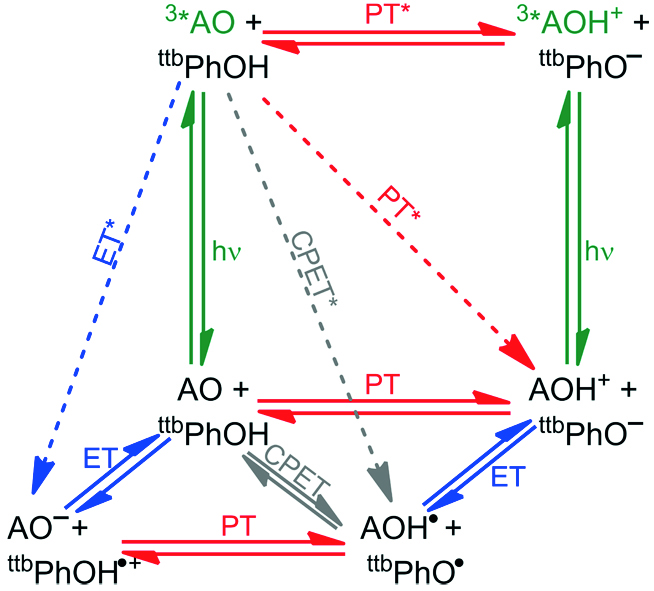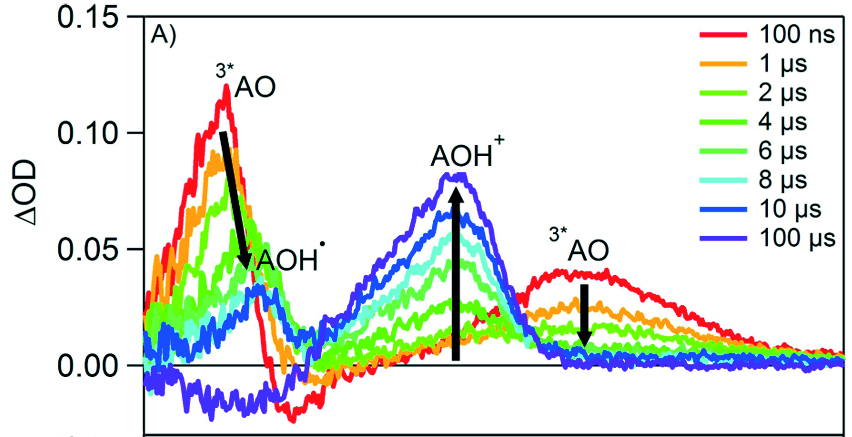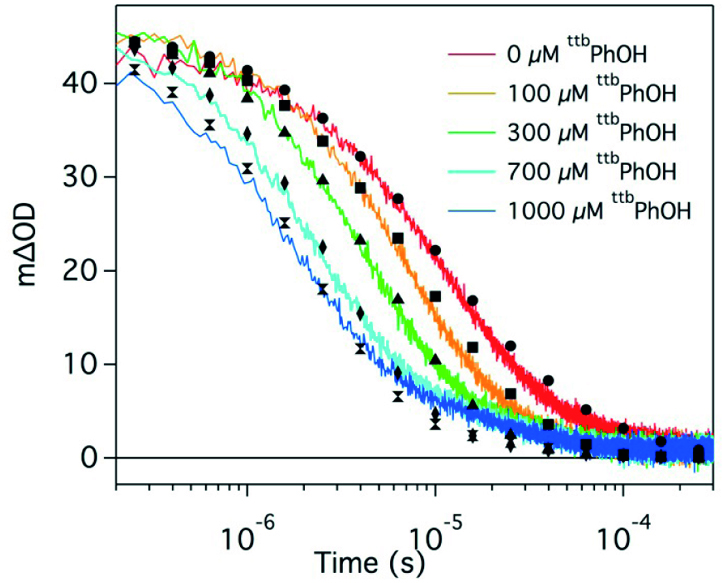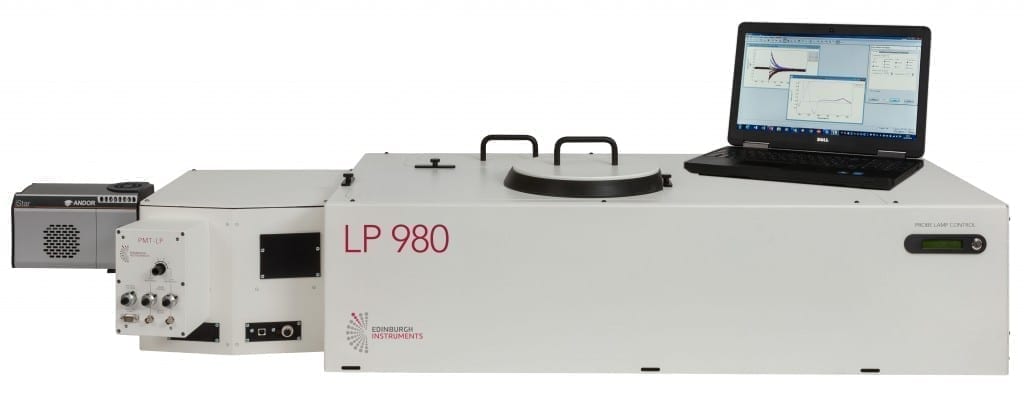Proton-Coupled Electron Transfer (PCET); Spectral and Kinetic Transient Absorption Analysis of Acridine Orange with Tri-Tert-Butylphenol
Understanding fundamental photo-induced proton-coupled electron transfer (PCET) reactions of small molecules is central to research ranging from solar fuels, biological signalling, and organic electronics. By combining spectral and kinetic information of the photo-generated excited states and radical species present, researchers are able to elucidate the PCET reaction mechanisms involved in these applications. The Edinburgh Instruments LP Transient Absorption Spectrometer is the world’s only commercial system capable of recording instantaneous spectral information utilising an ICCD camera, while then easily being able to switch to measuring kinetic data on a PMT detector – all under software control. It was used to carry out the research in this application note.
Research
Researchers at the University of North Carolina, Chapel Hill, in the lab of Prof. Jillian L. Dempsey, have utilised an Edinburgh Instruments LP laser flash photolysis spectrometer equipped with an ICCD camera and PMT detector to record the spectral and kinetic PCET reaction mechanisms of a famous fluorophore, acridine orange (AO), with tri-tert-butylphenol (ttbPhOH) (J. Am. Chem. Soc. 2014, 136, 12221-12224).
Figure 2: PCET mechanistic pathways between photo-excited acridine orange (AO) and tri-tert-butylphenol (ttbPhOH).
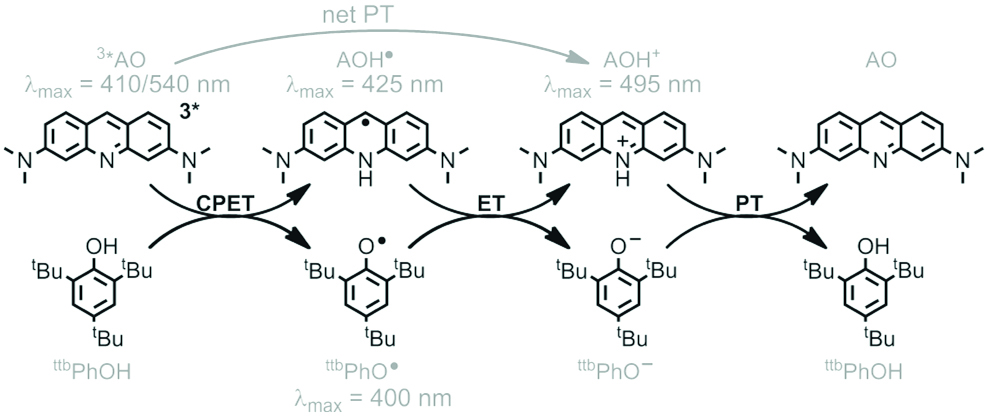 Acridine orange is well known for its ability to stain DNA and RNA in cellular imaging, however, it also posses efficient intersystem crossing and a long-lived triplet state with a well defined radical cation; ideal for monitoring photo-induced PCET reactions. Phenols, such as tri-tert-butylphenol, have long been studied given their close resemblance to tyrosine and its importance in photosystem II solar harvesting, making this a perfect combination for fundamental photochemistry studies.
Acridine orange is well known for its ability to stain DNA and RNA in cellular imaging, however, it also posses efficient intersystem crossing and a long-lived triplet state with a well defined radical cation; ideal for monitoring photo-induced PCET reactions. Phenols, such as tri-tert-butylphenol, have long been studied given their close resemblance to tyrosine and its importance in photosystem II solar harvesting, making this a perfect combination for fundamental photochemistry studies.
Figure 3: Photo-induced transient absorption spectra of 40 μM acridine orange during the PCET mechanism with 1 mM tri-tert-butylphenol (ttbPhOH) in acetonitrile; excitation was at 425 nm.
The defined spectral features (Figure 3) of each species during the PCET reaction with acridine orange is easily recorded using the ICCD camera, even noting the bathochromic shift from the triplet excited state (3AO) at 410 nm to the neutral acridine radical (AOH*) at 425 nm. Further concentration studies show drastic changes in lifetime, with increased tritert-butylphenol (ttbPhOH) quenching the triplet acridine orange excited state (Figure 4).
Figure 4: Triplet lifetime of acridine orange in the presence of increased concentrations of tri-tert-butylphenol (ttbPhOH) in acetonitrile; lifetimes were recorded at 560 nm.
Conclusion
Utilising model compounds with distinguishable transient spectral features facilitates fundamental understandings of PCET events that could benefit new device designs for solar harvesting and better insights into biological signalling. The Edinburgh Instruments LP980 Spectrometer, with both ICCD spectral and PMT kinetic detectors is impeccably suited for these measurements, among many more.
Link to Article: https://pubs.acs.org/doi/10.1021/ja505755k
Figures reprinted with permission from J. Am. Chem. Soc. 2014, 136, 12221-12224. Copyright 2014 American Chemical Society.
Download the PCET Application Note
LP980
The LP980 leads the way in Transient Absorption and Laser-Induced Fluorescence. It offers unrivaled measurement capabilities in the fields of chemical, physical and biological applications. For further information on the LP980 simply contact one of our sales team at sales@edinst.com.
Stay in Touch
If you have enjoyed this application note, and want to be the first to see all the latest news, applications, product information then sign-up to our infrequent newsletter via the red sign-up button below, and follow us on social media.









